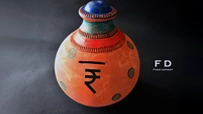Why You Should Book Your Fixed Deposit Now, Before FD Rates Are Cut
July 29, 2025

The Reserve Bank of India (RBI) has recently cut the repo rate by 50 basis points, bringing it down to 5.50%. This is the third rate cut in a row this year, signalling a shift toward lower interest rates across the economy. While this move is welcome news for borrowers – home loan EMIs are set to decrease – it has a flipside for savers. Fixed deposit (FD) interest rates are poised to drop, which means regular depositors and senior citizens could earn less on new deposits going forward. In this blog, we explore why it’s important to lock in an FD now before banks slash FD rates, and how you can make the most of the current scenario.
RBI’s Repo Rate Cut: What It Means for Depositors
When the RBI reduces the repo rate – the rate at which it lends to commercial banks – it lowers banks’ cost of funds. In response, banks typically reduce their lending rates (making loans cheaper) and also cut deposit interest rates to maintain their profit margins. The latest 50 bps repo rate cut to 5.5% is significant. It means banks may soon likely announce lower interest rates on new FDs and savings accounts.
For depositors, especially individuals and retirees, this is a pivotal moment. Depositors face an interest rate downturn, meaning the attractive FD rates offered in recent months could diminish quickly. Banks have already been trimming deposit rates after earlier RBI cuts this year.
Falling Interest Rates and Your Fixed Deposits
FD interest rates are already on a downward trend. Banks often move quickly to adjust deposit rates once the RBI announces a cut. In the past few months, as RBI eased policy rates, barring a few banks like Ujjivan SFB, which underwent a marginal rate revision, most banks have aggressively lowered FD rates for various tenures.
At the same time, a few institutions still offer relatively high rates for now. For example, Ujjivan Small Finance Bank (Ujjivan SFB) offers high-interest FDs ideal to meet your financial goals and aspirations. However, such high rates may not last for long.
The takeaway: Interest rates on deposits are headed south. If you wait for even a few weeks or months, the FD rates available then could be substantially lower than what you can get today. Therefore, acting now can secure you a better deal.
What Happens if You Lock Your FD Now?
The good news is that fixed deposits allow you to lock in a rate for the entire tenure of your deposit. If you open an FD today, you will continue to earn the agreed interest rate until it matures, even if the bank cuts rates for new FDs tomorrow. This is a key benefit of FDs – the rate is fixed upfront and doesn’t fluctuate with market conditions.
So, booking an FD now essentially locks in the current higher interest rate for you. For instance, suppose your bank currently offers up to 7.60% annual interest on 18-month FD. If you invest now, you’ll get 7.60% interest rate – even if the bank reduces the rate tomorrow – no questions asked.
Locking the rate now means earning more interest on your savings than what late-comers will get. Whether you’re saving for a goal or just parking surplus funds safely, a higher fixed return will accelerate your wealth accumulation more than a lower one.
If you already have existing FDs, they are safe at their current rates until maturity. Those do not get reduced mid-way. The concern is for new deposits or renewals going forward – those would fetch the new lower rates. That’s why, if you have an FD maturing soon or idle money to invest, doing it before banks announce rate cuts is wise.
Why Booking FDs Now Makes Sense (Especially for Senior Citizens)
For senior citizens, the falling interest rate scenario is even more crucial. Many retirees depend heavily on interest from FDs for their regular income and financial security. Banks typically offer an additional interest rate (for example, +0.50%) to senior citizen depositors as a benefit. But that extra is over the base rate – which means if base rates fall, the absolute interest they earn falls too (even if the spread remains).
Consider Medium to Long Tenures for Your FDs
A key decision when booking an FD is the tenure (duration) you choose. In a falling interest rate cycle, opting for a longer tenure can be beneficial for maximizing returns, provided you won’t need that money immediately. Here’s why:
Note: Be mindful of your liquidity needs. Do not lock all your money in long FDs if you might require some of it in the near future. For sums you might need in 6–12 months, a shorter FD or a different instrument is more appropriate. The goal is to maximize interest on the funds you are confident you can keep aside for the long term.
Laddering Your FDs for Flexibility and Better Returns
One smart strategy to consider now is FD laddering – this is especially useful for senior citizens or anyone who wants both good returns and some liquidity.
What is laddering? Laddering means instead of putting all your money into one fixed deposit, you divide it into multiple FDs of staggered maturities. For example, if you have ₹5 lakhs to invest, you could split it into five FDs of ₹1 lakh each with tenures of 1, 2, 3, 4, and 5 years respectively (that’s one example of a ladder). Each year one FD will mature, and you can reinvest that amount accordingly.
Final Thoughts
Interest rate cycles are a normal part of the economic landscape. We happen to be at a point where rates are trending down as the RBI aims to stimulate growth and manage inflation. For depositors, this means acting promptly is crucial. By booking or renewing your fixed deposits right now, you can grab the best interest rates available and secure your income from these deposits for the coming years. Regular depositors can benefit from higher compounded returns, and senior citizens can preserve their much-needed interest income by locking in higher rates.
Looking to grow your savings faster? Ujjivan SFB offers a wide range of fixed deposit products. Select the FD of your choice and take a step forward to your financial goals. Alternatively, you can browse through Ujjivan SFB product suite - our wide range of financial products are designed to make your financial life better.
Disclaimer:
The contents herein are only for informational purposes and generic in nature. The content does not amount to an offer, invitation or solicitation of any kind to buy or sell, and are not intended to create any legal rights or obligations. This information is subject to updation, completion, amendment and verification without notice. The contents herein are also subject to other product-specific terms and conditions, as well as any applicable third-party terms and conditions, for which Ujjivan Small Finance Bank assumes no responsibility or liability.
Nothing contained herein is intended to constitute financial, investment, legal, tax, or any other professional advice or opinion. Please obtain professional advice before making investment or any other decisions. Any investment decisions that may be made by the you shall be at your own sole discretion, independent analysis and evaluation of the risks involved. The use of any information set out in this document is entirely at the user’s own risk. Ujjivan Small Finance Bank Limited makes no representation or warranty, express or implied, as to the accuracy and completeness for any information herein. The Bank disclaims any and all liability for any loss or damage (direct, indirect, consequential, or otherwise) incurred by you due to use of or due to investment, product application decisions made by you on the basis of the contents herein. While the information is prepared in good faith from sources deemed reliable (including public sources), the Bank disclaims any liability with respect to accuracy of information or any error or omission or any loss or damage incurred by anyone in reliance on the contents herein, in any manner whatsoever.
To know more about Ujjivan Small Finance Bank Products Visit:"https://www.ujjivansfb.in"
All intellectual property rights, including copyrights, trademarks, and other proprietary rights, pertaining to the content and materials displayed herein, belong
to Ujjivan Small Finance Bank Limited or its licensors. Unauthorised use or misuse of any intellectual property, or other content displayed herein is strictly prohibited and the same is not intended for distribution to, or use by, any person in any jurisdiction where such distribution or use would (by reason of that person’s nationality, residence or otherwise) be contrary to law or registration or would subject Ujjivan Small Finance Bank Limited or its affiliates to any licensing or registration requirements.
FAQs
1. How does the RBI’s repo rate cut affect fixed deposit interest rates?
When RBI cuts the repo rate, it lowers banks’ borrowing costs. Banks often respond by reducing interest rates on loans and on deposits. So a repo rate cut typically leads banks to cut their FD interest rates as well (though the timing and exact amount of reduction can vary by bank). In short, a lower repo usually means new FDs will offer lower rates than before.
2. Is it a good time to invest in a fixed deposit now?
Yes, it’s a very good time if you want to lock in the currently higher rates. With interest rates poised to fall further, investing in an FD now means you secure today’s rate for your deposit tenure. Waiting longer could result in getting a substantially lower rate. Of course, ensure you choose a tenure and bank that suit your needs, but generally, sooner is better than later in a falling rate scenario.
3. What happens to my existing FDs? Will they be affected by the rate cut?
Existing fixed deposits are not affected by the rate cut. Any FD you have already opened at a fixed rate will continue to earn that contracted interest rate until it matures. The repo rate cut only affects new FDs or renewals. For example, if you have an ongoing FD at 7% for 2 years, it will stay at 7% till maturity. However, when you renew or open a new FD, then the prevailing (now lower) rates will apply.
Latest Blogs

Dussehra 2025: How to Win Your Financial Battles with Smart Saving
Dussehra 2025 (also known as Vijayadashami) falls on Thursday, October 2, 2025.

eSIM Scam in India: I4C Warns Mobile Users About Rising Fraud – How to Stay Safe
The Indian Cybercrime Coordination Centre (I4C), a wing of the Ministry of Home Affairs, issued a strong warning to mobile users about the rapid increase in eSIM fraud in India.

How to Link PAN with Aadhaar: Step-by-Step Guide & Consequences of Not Linking
Linking your Permanent Account Number (PAN) with your Aadhaar is no longer just a best practice.

Annual Information Statement (AIS): A Complete Guide for Stress-Free ITR Filing
India’s tax season is in its final stretch.

ITR-1 (Sahaj) Restrictions: Income Sources Not Allowed & Filing Rules
With just a few days left before the 15 September 2025 deadline for filing Income Tax Returns (ITRs) for Assessment Year (AY) 2025-26, many taxpayers are rushing to submit their forms online.





